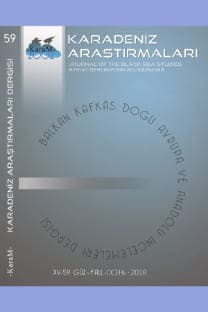Estonya'nın Karşılaştırmalı Tarihi Üzerine Notlar
Bu makalede, Eston ve Türk tarihinden örnekler vermek suretiyle, Türk-Eston etkileşimine dair bazı tarihsel ipuçlarına ve olasılıklara ulaşılması amaçlanmıştır. Estonca ile Türkçe arasındaki dil akrabalığı gibi bilinen hususlara değinmenin yanısıra, 20.yüzyıl itibariyle Türkiyede ve Estonyada yaşanan gelişmelerin birlikte yo-rumlanmasını temin edecek bir yaklaşım tercih edilmiştir. Bu suretle, henüz yeterince çalışılmamış olan bir sahada, Türkiye ve yurtdışındaki akademik merakın artırılması ve Türk kültür dairesi ile etkileşimi tarihsel olarak eskilere uzanan Estonyanın, özellikle Türkiye Cumhuriyeti dönemine denk gelen bir süreçte yaşadıklarının, bazı somut veriler üzerinden kıyaslanması ile, Türk-Eston araştırmalarının teşvik edilmesi öngörülmektedir.
A Few Notes on the Comparative History of Estonia
Estonia within the essentially Baltic framework though differing linguistically from Baltic German-rooted/or Baltic Slavic-rooted people draw attention by virtue of her socio-cultural depth, which is certainly disproportionate to her relatively small population. The popularity and usage of the Estonian language has held an important place in Eston peoples cultural heritage within the continuation of its existence, sustaining its identity against the passage of time. A better understanding of the historical issues which overlap with the Turkish and Estonian cultural wealth and political life may be obtained through a comparative study of the history of both countries. Therefore, instead of introducing a great number of contradictory views or materials, this study aims to encourage further scholarly curiosity by assessing the destiny and the similarities or differences within the history of state foundation and that of cultural background of the two countries.Primarily, it should be remembered, not only in terms of cultural interaction but also in terms of the bilateral relations between Turkey and Estonia, that Atatürks Turkey had been one of the first countries to have recognized (in 1924) the independence of Estonia declared in 1918.
___
- ALMOND, Mark, Europe’s Backyard War: the War in the Balkans, London 1994.
- Ayın Tarihi, Vol.22, Ankara 1935.
- “Convention de Commerce et de Navigation”, by the Turkish Ministry for Foreign Affairs, (imp.Ebuzzia, Stanboul), Ankara 1928.
- Düstur (Code of Laws), Vol.20 (Ankara 1958) and Vol.21 (Ankara 1961).
- Finlandiya, Estonya, Letonya, Litvanya Orduları 1929-1930, Ankara 1931.
- HUANG, Mel, “Estonia” in Eastern Europe:An Introduction to the People, Lands, and Culture, edited by Richard Frucht, Vol.I , Santa Barbara 2005.
- GÜLMEZ, Nurettin, Kurtuluş Savaşı’nda Anadolu’da Yeni Gün, Ankara 1999.
- KARATAY, Osman, Hırvat Ulusunun Oluşumu, Ankara 2000.
- KIONKA, Riina, “Estonians” in The Nationalities Question in the Soviet Union, edited by Graham Smith, London 1993.
- LOROT, Pascal, Baltık Ülkeleri (Les pays baltes), translated by Hüsnü Dilli, İstanbul 1991.
- MOSS, Joyce-George Wilson, Eastern Europe and the Post-Soviet Republics, Detroit 1993.
- ÖZDOĞAN, Günay Göksu, “Dünyada ve Türkiye’de Turancılık” in Milliyetçilik, ed- ited by Tanıl Bora, İstanbul 2002.
- RAUCH, Georg von, The Baltic States: the Years of Independence 1917-1940, London 1974.
- RUUTSOO, Rein, Civil Society and Nation Building in Estonia and the Baltic States, Ro- vaniemi 2002.
- SMITH, Gordon B., Soviet Politics: Continuity and Contradiction, London 1988.
- SUTROP, Urmas, “Taarapita—the Great God of the Oeselians”, Trames (3/2004, Estonia).
- ŞİMŞİR, Bilal, Atatürk ve Yabancı Devlet Başkanları II, No.41: From Turkish President K.Atatürk to President Konstantin Paets (Ankara, 12 March 1935), Ankara 2001.
- WHITE, Stephen (ed), Political and Economic Encyclopaedia of the Soviet Union and East- ern Europe, London 1990.
- ISSN: 2536-5126
- Yayın Aralığı: Yılda 4 Sayı
- Başlangıç: 2004
- Yayıncı: Osman Karatay
Sayıdaki Diğer Makaleler
Kitap Değerlendirme: Seyit Sertçelik, Rus ve Ermeni Kaynakları Işığında Ermeni Sorunu
Amerikan Arşiv Belgelerine Göre İzmirin Boşaltılması ve Rum Göçmenlere Yardım Konusu
Estonya'nın Karşılaştırmalı Tarihi Üzerine Notlar
Kitap Değerlendirme: Necati Demir-Özkan Aydoğdu, Giresun İli ve Yöresi Ağızları
Samet Vurgun'un Şiirlerinde Millî Hafıza
